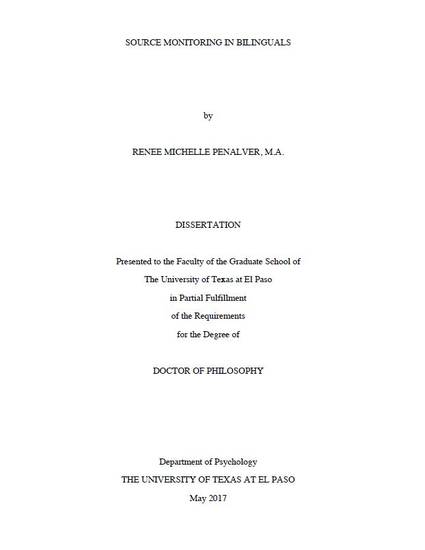
Dissertation
Source Monitoring in Bilinguals
(2017)
Abstract
Source memory is memory for the context in which a particular target item is learned (Parker, 1995). The source-monitoring framework is the leading model of source memory (Johnson, Hashtroudi, & Lindsay, 1993). It remains unknown at what level context-to-word associations, including source contexts, are made (e.g., at the word form level or conceptual level). Three experiments examined the effects of word frequency and language proficiency on source memory, with each experiment addressing one of the different types of source monitoring identified in the source-monitoring framework. In Experiment 1, we examined how language proficiency and word frequency affect external source discrimination between auditory and visual stimuli. In Experiment 2, we examined how these same variables affect internal source discrimination between overt and covert picture naming. In Experiment 3, we examined how internal-external source monitoring is affected by language proficiency and word frequency by having participants remember whether they listened to words or only imagined listening to words. The results revealed information about the level at which contextual information is represented. Prior to this study, it remained relatively unexplored about the level word-to-context associations were made. We hypothesized that if we observed an effect of word frequency, then word-to context associations are being made at the conceptual level. Furthermore, we hypothesized that if we observed an effect of language proficiency, then word-to-context associations are being made at the word-form level. The frequency-lag hypothesis was developed to explain performance in lexical processing tasks, with logic that L2 words function like low-frequency words. It remains unknown whether this analogy works for explicit memory. Manipulations of word frequency were expected to yield an advantage in source memory for low-frequency words relative to high-frequency words in all three experiments based on the source-of-activation confusion theory (e.g. low-frequency item advantage in recognition memory). Indeed, participants did show better source discrimination for low frequency words. Manipulations of language were expected to yield better source memory for words in the non-dominant language relative to words in the dominant language across all three experiments based on an adaptation of the source-of-activation confusion theory where items in the nondominant language are expected to behave like low frequency words. However, no effects of language were observed for any of the three types of source monitoring. It has not yet been specified in any theories of source memory or bilingual memory at what level context-to-word associations are being made. Based on the current results, it seems as though the context-to-word associations are being made at the conceptual level rather than the level of the word form. This research adds to an important body of literature examining the bilingual experience from a long-term memory perspective.
Disciplines
Publication Date
2017
Citation Information
Renee Michelle Penalver. "Source Monitoring in Bilinguals" (2017) Available at: http://works.bepress.com/renee-penalver/4/
